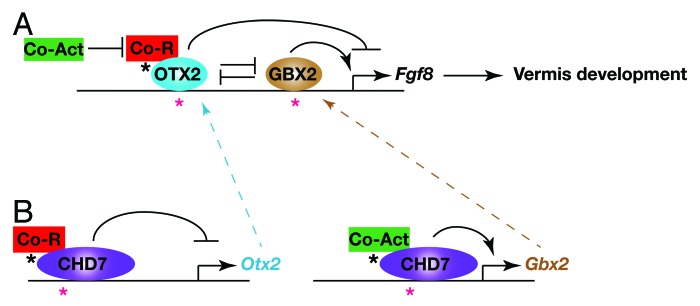
Figure 1. Gene regulatory interactions implicated in cerebellar vermis hypoplasia in CHARGE syndrome. The diagram depicts a model of the homeobox gene-regulatory network that impacts on Fgf8 expression at the IsO. Possible regulatory mutations that might result in de-regulated Fgf8 expression and cerebellar vermis hypoplasia are indicated by asterisks. (A) OTX2 represses Fgf8 expression by interacting with transcriptional co-repressors, such as Groucho (Co-R, Tle4/Grg4), whereas GBX2 acts as a positive regulator of Fgf8 expression, presumably through interacting with transcriptional co-activators (Co-Act). OTX2 and GBX2 cross-repress each other’s expression. Mutations in OTX2 or GBX2 regulatory regions (red asterisks) or mutations that affect the ability of these factors to recruit or activate co-activators or repressors (black asterisk) might affect Fgf8 expression levels and result in cerebellar vermis hypoplasia. (B) CHD7 functions as an Otx2 repressor and GBX2 activator in the mid-hindbrain region, possibly also through interacting with additional chromatin remodelling and transcriptional regulators that contribute to repressive or activator activities. Mutations in Otx2 or Gbx2 regulatory elements to which CHD7 are recruited (red asterisks) or mutations affecting the activity or recruitment of additional co-activating or repressing factors (black asterisks) are predicted to affect Otx2 or Gbx2 expression, which in turn will affect Fgf8 expression and cause cerebellar vermis abnormalities.
